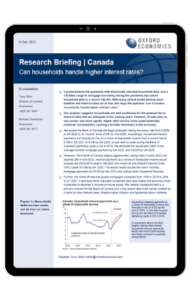Can Canadian households handle higher interest rates?

Canada entered the pandemic with historically elevated household debt, and a C$193bn surge in mortgage borrowing during the pandemic has raised household debt to a record C$2.5tn. With many central banks turning more hawkish and interest rates set to rise, this begs the question: Can Canadian households handle higher interest rates?
What you will learn:
- Our analysis suggests households are well positioned for the gradual rise in interest rates that we anticipate in the coming years.
- We expect the Bank of Canada will begin gradually raising the policy rate from 0.25% in Q4 2022 to its “neutral” level of 2% by mid-2026.
- However, if the Bank of Canada begins aggressively raising rates in early-2022 and reaches 2% in mid-2023, interest payments as a share of disposable income would surpass the 2018-2019 peak in Q4 2022 and match its pre Global Financial Crisis (GFC) peak of 10% by Q4 2026.
Tags:
Related Services

Post
APAC Key Themes 2026: Paybacks, policy offsets and trade
We believe APAC will remain the strongest global performer in 2026. However, the growth trajectory will likely be more uneven than in past cycles.
Find Out More
Post
Japan’s fiscal policy will remain loose, which increases risks to debt sustainabilit
We've changed our fiscal outlook for Japan in our December forecast round. We now expect the new government to set a primary deficit close to that of 2024, at 2%-3% of GDP for 2025-2027, instead of restoring a balanced budget by taking advantage of strong tax revenue. We assume higher bond yields will force the government to take measures to reduce the deficit from 2028.
Find Out More